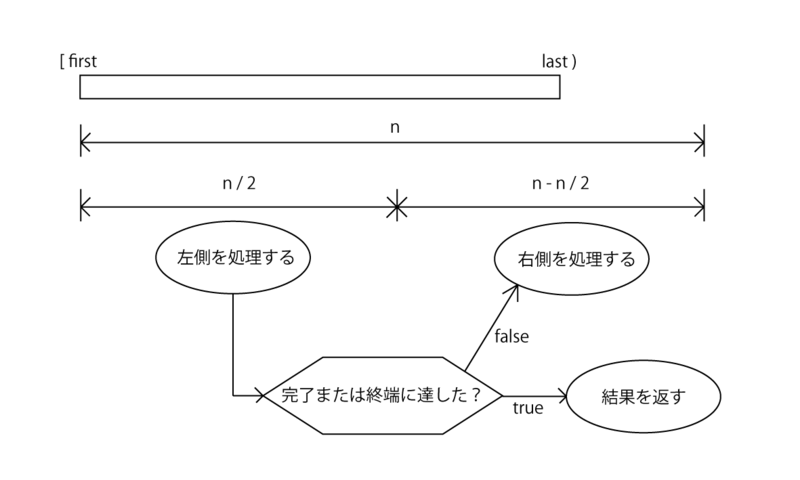constexpr アルゴリズムの実装イディオム その1
中3女子です。
今回は、constexpr におけるアルゴリズムの実装法について考える。
よく知られているように、constexpr 関数には言語規格上の制約が多くある。
ローカル変数が使えない、if や for などの制御構文が使えないなどは、C++11 に触れた者なら誰でも知っているだろう。
だが、それらは条件演算子や再帰によって、単純に代替できる問題である。
つまり、非 constexpr な実装に対して、処理の流れを本質的に変えることなく constexpr に書き換えることができる。
-
- 単純に書き換えられる例:
template<typename T> T const& runtime_min(T const& a, T const& b) { if (b < a) return b; return a; } template<typename T> constexpr T const& constexpr_min(T const& a, T const& b) { return b < a ? b : a ; }
しかしながら、単純な書き換えでは解決できない問題もある。
例えばコンパイル時の再帰深度の制限などである。
そのため、constexpr でより良いアルゴリズムを実装するためには、ケースに応じたイディオムによって constexpr 特有の問題を解決する必要がある。
distance の実装
std::distance(first, last) は、[first, last) なるイテレータ間の距離を求める関数である。
典型的な実装は以下のようになる。
-
- std::distance
template<typename RandomAccessIterator> typename std::iterator_traits<RandomAccessIterator>::difference_type distance_impl(RandomAccessIterator first, RandomAccessIterator last, std::random_access_iterator_tag*) { return last - first; } template<typename InputIterator> typename std::iterator_traits<InputIterator>::difference_type distance_impl(InputIterator first, InputIterator last, void*) { typename std::iterator_traits<InputIterator>::difference_type n = 0; for (; first != last; ++first) { ++n; } return n; } template<typename InputIterator> typename std::iterator_traits<InputIterator>::difference_type distance(InputIterator first, InputIterator last) { typedef typename std::iterator_traits<InputIterator>::iterator_category* category; return distance_impl(first, last, category()); }
これを“単純に” constexpr に書き直すと、以下のようになる。
#include <sprout/iterator/next.hpp> template<typename RandomAccessIterator> constexpr typename std::iterator_traits<RandomAccessIterator>::difference_type distance_impl(RandomAccessIterator first, RandomAccessIterator last, std::random_access_iterator_tag*) { return last - first; } template<typename InputIterator> constexpr typename std::iterator_traits<InputIterator>::difference_type distance_impl(InputIterator first, InputIterator last, void*) { return first == last ? 0 : 1 + distance_impl(sprout::next(first), last, (void*)0) ; } template<typename InputIterator> constexpr typename std::iterator_traits<InputIterator>::difference_type distance(InputIterator first, InputIterator last) { typedef typename std::iterator_traits<InputIterator>::iterator_category* category; return distance_impl(first, last, category()); }
for を再帰で代替し、++ は sprout::next で代替する。
sprout::next は、次のような挙動をする。
このような仕様は、通常 ++ 演算子は副作用を持つため、副作用を持たない constexpr iterator_next を、イテレータの実装者が用意できるようにするためである。
これで distance を constexpr 化できただろうか?
残念ながら、この時点の実装には大きく二つの問題点がある。
問題1 : ポインタ同士の減算は定数式でない
第一の問題点は、コンパイル時にこの関数の引数にポインタを渡すと、コンパイルエラーになる。
static constexpr int arr[5] = {}; constexpr std::ptrdiff_t d = distance(arr, arr + 5); /* エラー! */
なぜなら、ポインタ型はランダムアクセスイテレータとして扱われるが、C++11 においては、ポインタ同士の減算は定数式ではない。
そのため、コンパイル時に、ポインタ型での last - first を評価するとコンパイルエラーになる。
これを解決するには、ポインタ型も非ランダムアクセスイテレータと同じように処理するようにする。
つまり、SFINAE でポインタ型を Lookup から除外すればよい。
template<typename RandomAccessIterator> constexpr typename std::enable_if< !std::is_pointer<RandomAccessIterator>::value, typename std::iterator_traits<RandomAccessIterator>::difference_type >::type distance_impl(RandomAccessIterator first, RandomAccessIterator last, std::random_access_iterator_tag*) { return last - first; }
ちなみに、次期標準の C++1y では、ポインタ同士の減算も定数式として扱えるようになる予定である。
問題2 : 再帰深度の制限
第二の問題点は、非ランダムアクセスかつ距離がコンパイラ定義の値(例えば 1024 だとか 512)を越えている場合、コンパイルエラーになる。
static constexpr int arr[5000] = {}; constexpr std::ptrdiff_t d = distance(arr, arr + 5000); /* エラー! */
前述の実装では、距離をカウントアップする毎に再帰しているが、コンパイル時の constexpr 関数の再帰には深度制限があるからである。
すぐに深度制限を超えてしまうのは、この実装では、距離 N を求めるのに再帰深度 Ο(N) を必要とするからだ。
もし再帰深度が対数オーダー Ο(logN) などであれば、そう簡単には深度制限を越えることはないはずである。
では、対数オーダーの再帰はどのように実装するか?
前提として、非ランダムアクセスな distance は、始端 first から順にカウントアップして終端 last に等しいイテレータを検索するアルゴリズムと捉えることができる。
まず、適当な検索範囲 n(n > 0)が与えられたと仮定する。(n >= N かもしれないし、n < N かもしれない)
上記を一つの処理単位とする。
マージソートのように範囲を二等分しながら処理するから、その再帰数は 2 の対数、つまり対数オーダーになる。
この処理単位について、
-
- 検索範囲 n について終端 last が見つからなかった(n < N)場合は、次の範囲を続けて検索する。
というように再帰する。
このとき、次の検索範囲は前回の倍の n * 2 を選ぶようにする。
すると、n == 1 から始めて(n >= N)となるのに必要な再帰数もまた 2 の対数、つまり対数オーダーである。
対数オーダーの処理を合成した処理もまた対数オーダーであるから、全体としても対数オーダーになる。
以上をコードに落とすとこのような実装となる。
#include <sprout/utility/pair.hpp> template<typename InputIterator> constexpr sprout::pair<InputIterator, typename std::iterator_traits<InputIterator>::difference_type> distance_impl_1( sprout::pair<InputIterator, typename std::iterator_traits<InputIterator>::difference_type> const& current, InputIterator last, typename std::iterator_traits<InputIterator>::difference_type n ) { typedef sprout::pair<InputIterator, typename std::iterator_traits<InputIterator>::difference_type> type; return current.first == last ? current : n == 1 ? type(sprout::next(current.first), current.second + 1) : distance_impl_1( distance_impl_1( current, last, n / 2 /* 左側を検索 */ ), last, n - n / 2 /* 右側を検索 */ ) ; } template<typename InputIterator> constexpr sprout::pair<InputIterator, typename std::iterator_traits<InputIterator>::difference_type> distance_impl( sprout::pair<InputIterator, typename std::iterator_traits<InputIterator>::difference_type> const& current, InputIterator last, typename std::iterator_traits<InputIterator>::difference_type n ) { typedef sprout::pair<InputIterator, typename std::iterator_traits<InputIterator>::difference_type> type; return current.first == last ? current : distance_impl( distance_impl_1( current, last, n /* 検索範囲 n を検索 */ ), last, n * 2 /* 次の検索範囲 n * 2 を検索 */ ) ; } template<typename InputIterator> constexpr typename std::iterator_traits<InputIterator>::difference_type distance_impl(InputIterator first, InputIterator last, void*) { typedef sprout::pair<InputIterator, typename std::iterator_traits<InputIterator>::difference_type> type; return distance_impl(type(first, 0), last, 1).second; }
pair を使っているのは、constexpr 関数では状態をローカル変数に保存できないため、
現在のイテレータとカウントを纏めて、引数と返値でやりとりするためである。
上記のような処理手順を呼出順に、より一般的に書くと、下記のようになる。
もちろん、長さが既知である場合は、手順 1 は不要である。
ちなみに手順 2 の方法は、Sprout ライブラリでは、テイラー展開による数学関数の実装などにも用いられている。
このようなイディオムを使うことで、constexpr アルゴリズムについて、入力の長さ N に対して再帰深度 Ο(logN) の処理を書くことができる。
例えば検索(find, search 等)、カウント(const 等)、叙述(all_of 等)すべてに適用することができる。
アルゴリズム毎に合わせて考える必要があるが、概ね次の点を考えれば当てはめることができる。
-
- 処理を完了する条件
- 最小単位に対する処理
- 必要な状態変数
中3女子ならば、アルゴリズムの効果と要件を見れば、自然にこのように問題を分解して考えることができる。
実際、Sprout ライブラリの STL 互換の(副作用のない)アルゴリズムはすべてこのような実装になっている。
ゆえに、副作用のない STL アルゴリズムはすべて、高々再帰深度 Ο(logN) で constexpr 化できることが実証されている。
このように、constexpr 特有の問題であっても、とても明快でわかりやすいイディオムで解決することができる。
次回は、定数式においてポインタを効率的にイテレータとして用いる方法について書こうと思う。
